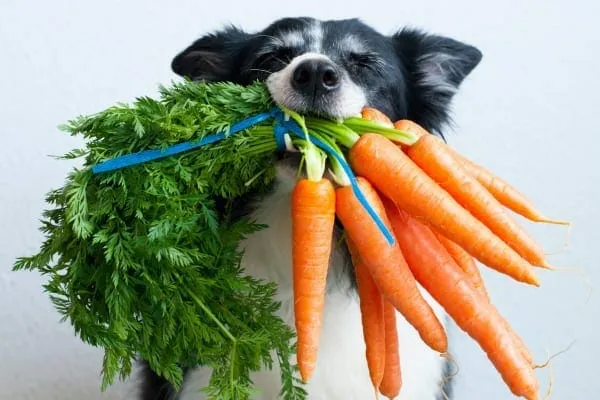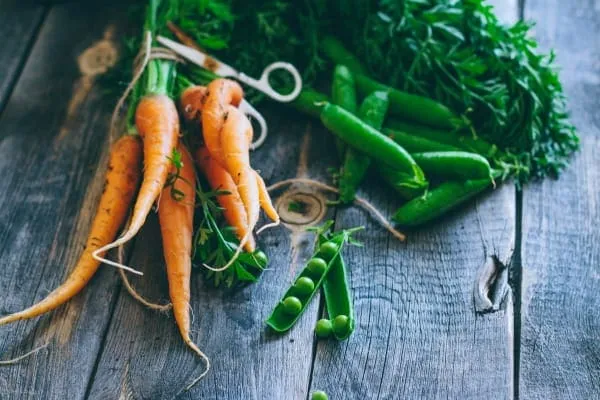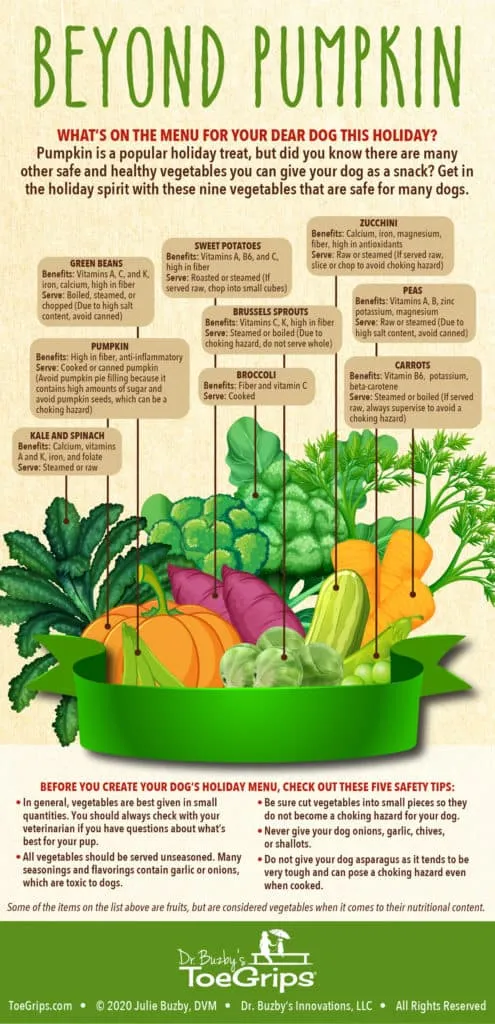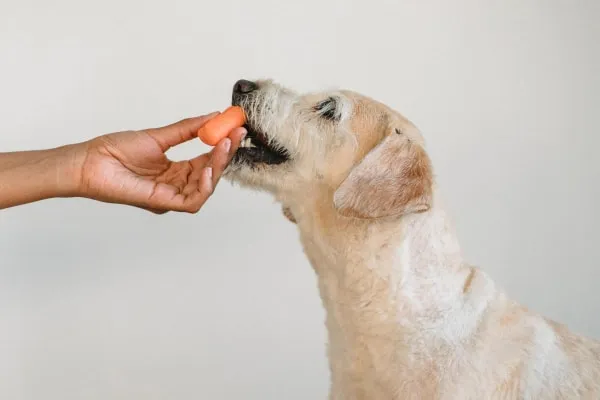Can dogs eat vegetables? Absolutely! Many nutrient-rich veggies make excellent canine snacks, offering a wealth of health benefits. But with so many options, knowing which ones are safe, and equally important, which ones are not, can be a challenge. As experts in pet care, we’re here to guide you through the best vegetable choices for your furry friend, ensuring their diet is both nutritious and safe.
From aiding digestion to supporting a healthy immune system, incorporating the right vegetables into your dog’s diet can be a game-changer. Just like humans, dogs can benefit significantly from the vitamins, minerals, and fiber found in various plant-based foods. This guide, approved by veterinary insights, will help you understand the benefits, discover 14 vet-approved vegetables your dog can safely enjoy, and highlight four critical ones you should never feed them. We’ll also provide practical tips on how to prepare these healthy treats, making sure your dog gets the most out of their veggie snacks. Understanding what is good human food to feed dogs is key to responsible pet ownership, and vegetables are a fantastic starting point.
What Are Some of the Benefits of Giving Dogs Vegetables?
Veggies are delicious and nutritious, whether given as occasional snacks or as supplements to your dog’s regular diet. They contribute significantly to your dog’s overall well-being. Here are just a few of the general benefits your dog can gain from a diet that includes safe vegetables:
- Weight Management: For dogs who are overweight, vegetable treats are a smart choice. They are typically low in calories and high in fiber, which helps your dog feel full faster and stay satisfied for longer. This reduces the likelihood of overeating or constantly begging for food. Many veterinarians, including Dr. Julie Buzby (whose insights inform much of our content), often recommend incorporating vegetables like green beans into meals to help combat hunger while reducing calorie intake in dieting dogs.
- Digestive Health: The ample fiber found in many vegetables is crucial for a healthy digestive tract. It promotes regular bowel movements, aids in healthy anal gland function, and helps prevent both constipation and diarrhea by regulating stool consistency.
- Immune Health: Vegetables are packed with vital nutrients like Vitamin C, beta-carotene, and various antioxidants that can significantly boost your dog’s immune system, helping them fight off illnesses and stay healthy.
- Diabetes Management: For dogs with diabetes, certain vegetables can play a beneficial role in regulating blood sugar levels due to their low glycemic index and high fiber content. Always consult your veterinarian before making significant dietary changes for a diabetic dog.
- Antioxidant Powerhouse: Many vegetables are natural sources of powerful antioxidants. These compounds help to neutralize free radicals in the body, which can reduce cellular damage and lower the risk of various diseases, contributing to a longer, healthier life for your dog.
- Training Rewards: Given their low-calorie nature and often satisfying crunch, vegetables can make excellent, motivating treats during training sessions. Crunchy options like carrots are particularly effective for some dogs.
14 Vegetables Safe for Dogs to Eat
As any responsible pet owner knows, not all “human food” is safe for dogs. Before introducing any new food outside of their regular diet, it’s essential to confirm its safety. Fortunately, there are many vegetables your dog can eat that are not only safe but also incredibly beneficial. The following are our top 14 vet-approved favorites, complete with their benefits and recommended preparation methods.
1. Pumpkin
Putting aside the ongoing debate about whether pumpkins are technically fruits or vegetables, they unequivocally top our list of dog-safe options! Pumpkin is a powerhouse, especially for senior dogs, thanks to its high fiber content. This makes it an excellent ally against common stool problems. If your dog experiences diarrhea, the fiber acts by absorbing excess water, helping to firm up their stool. Conversely, if constipation is an issue, the added fiber helps to gently move things along, promoting regularity.
Beyond digestion, pumpkin also contains pepita oil, rich in linoleic acid—an omega-6 fatty acid known for its anti-inflammatory properties, particularly beneficial for your dog’s skin health.
Cooked or plain canned pumpkin is the easiest and most recommended way to serve it. When shopping, always double-check the label to ensure you’re getting plain pumpkin puree, not pumpkin pie filling, which contains harmful added sugars and spices. Introduce pumpkin gradually, mixing one to two tablespoons with their regular food. Don’t be surprised if your dog’s stool takes on a slightly orange hue—this is normal.
2. Broccoli
Broccoli is another excellent vegetable that dogs can eat, serving as a superb source of fiber and Vitamin C, which is vital for a robust immune system. It’s best served cooked and unseasoned. Small pieces of raw broccoli stalks are also acceptable and can be a fantastic low-calorie crunchy treat that many dogs love.
To prevent choking, always ensure broccoli is served in bite-sized pieces, especially for smaller breeds. It’s important to offer broccoli in limited quantities, as excessive consumption can sometimes lead to irritation of the esophagus and stomach lining, or even cause stinky gas due to its fibrous nature.
3. Carrots
Carrots are a wonderful choice for dogs, packed with potassium, Vitamin B6, and an outstanding source of beta-carotene.
 A golden retriever happily holding a whole carrot in its mouth, enjoying a crunchy vegetable snack.Carrots are a popular crunchy treat for dogs, offering vital nutrients and dental benefits.
A golden retriever happily holding a whole carrot in its mouth, enjoying a crunchy vegetable snack.Carrots are a popular crunchy treat for dogs, offering vital nutrients and dental benefits.
Beta-carotene is responsible for carrots’ vibrant orange color and is converted into Vitamin A in your dog’s body. Vitamin A is an essential nutrient that supports immune function and vision, preventing issues like night blindness. Many dog owners prefer to serve carrots steamed or boiled. A one-ounce serving contains only ten calories, making them a filling, low-calorie option perfect for dogs needing to manage their weight. Raw carrots are also a favorite for their satisfying crunch.
Always supervise your dog and cut carrots into appropriately sized pieces to prevent choking. While generally healthy, carrots are relatively high in natural sugars, so they should be given sparingly to diabetic dogs or avoided if advised by your vet.
4. Green Beans
Green beans are a fantastic source of vitamins A, C, and K, along with essential minerals like iron and calcium. Their low-calorie and high-fiber content make them incredibly beneficial, especially for dogs with diabetes as they can help regulate blood sugar, and for dieting dogs as they promote a feeling of fullness.
Serve green beans boiled, steamed, or chopped. Crucially, avoid adding any seasonings, and steer clear of canned green beans that often contain excessive amounts of salt. Start by offering two to three green beans a day, ensuring that treats never exceed ten percent of your dog’s total daily caloric intake unless otherwise directed by your veterinarian.
5. Kale and Spinach
Dark, leafy greens like spinach and kale are excellent vegetable choices for your dog, brimming with beneficial nutrients:
- Calcium: Essential for strong, healthy bones.
- Vitamin K: Crucial for proper blood clotting.
- Vitamin A: Supports good vision and immune health.
- Iron: A key component of hemoglobin, facilitating oxygen transport in red blood cells.
- Folate: Necessary for nutrient absorption in the small intestines.
Kale and spinach can be served steamed or raw, but always without seasonings. One or two raw leaves make a perfect snack, or you can shred them and mix them into your dog’s meal. However, moderation is key with kale; its high calcium content can contribute to urinary problems and bladder stones in susceptible dogs. If your dog is prone to bladder stones or has a metabolic disease, consult your veterinarian before adding kale to their diet.
6. Brussels Sprouts
Brussels sprouts are another fiber-rich vegetable packed with vitamins C and K, and trace minerals like magnesium, which is vital for cellular metabolism and muscle function. When preparing Brussels sprouts for your dog, avoid any oils or seasonings. Start with just one or two at a time. Overfeeding can lead to excessive gas and bloating, causing abdominal discomfort.
Serve Brussels sprouts steamed or boiled, and always cut them into smaller pieces. Whole, round Brussels sprouts can pose a choking hazard, especially for small and medium-sized dogs.
7. Zucchini
Zucchini is a healthy addition, containing calcium, iron, magnesium, and fiber, all contributing to a healthy gastrointestinal tract. It can be served raw or steamed. Steaming makes it softer and easier to chew, which might be preferable for dogs who don’t enjoy crunchy textures.
Begin by offering three to four slices at a time. Crucially, avoid zucchini with seasonings or salad dressings. Many of these contain garlic and onions, which are highly toxic to dogs. Some dressings also include xylitol (birch sugar), an artificial sweetener that is extremely dangerous for dogs, potentially causing hypoglycemia, seizures, liver failure, and even death. Familiarizing yourself with what foods dogs can t have is critical for their safety.
8. Sweet Potatoes
Sweet potatoes are a high-fiber, incredibly tasty treat that you’ll often find in commercial dog foods. They are an excellent source of vitamins A, B6, and C. There are several ways to serve sweet potatoes to dogs. If fed raw, they should be chopped into small, manageable cubes. Steaming or roasting them makes them much softer, enhances their flavor, and significantly reduces the choking risk. Introduce sweet potatoes by giving your dog three or four slices at a time.
Like carrots, sweet potatoes have a higher sugar content, so they should be avoided or given in very small quantities to overweight or diabetic dogs.
9. Peas
Snow peas and sugar snap peas are great for your dog! They are a good source of vitamins A and B, and minerals like potassium and magnesium. Zinc, another mineral found in peas, plays an important role in a healthy immune system and proper thyroid gland function.
To feed your dog peas, steam or boil them. A one-ounce serving contains just twenty calories, making them a perfect low-calorie snack.
 A bowl filled with green peas and another with sliced carrots, both safe and healthy vegetables for dogs.Avoid canned vegetables when possible, as they can contain too much sodium for your dog. Fresh or frozen (plain) options are better.
A bowl filled with green peas and another with sliced carrots, both safe and healthy vegetables for dogs.Avoid canned vegetables when possible, as they can contain too much sodium for your dog. Fresh or frozen (plain) options are better.
Always avoid canned peas that often have high salt contents. Peas also contain purines, a type of protein, so dogs with urinary incontinence or kidney issues should generally avoid them or consume them only under veterinary guidance.
10. Corn
Corn is a common ingredient in many dog foods and, despite sometimes being unfairly labeled as a “filler,” it offers several nutritional benefits:
- Easily Digestible Carbohydrates: Provides a great energy source for active dogs.
- Linoleic Acid: An essential fatty acid that dogs cannot produce on their own. Supplementing through corn helps maintain healthy skin, a shiny coat, and a strong immune system.
- Rich in Fiber: Supports digestive health and promotes gut motility.
While corn kernels are safe, corn on the cob is not. The cob is indigestible and can easily become lodged in your dog’s stomach or intestines, potentially causing severe internal damage or requiring emergency surgery. If you want to give your dog corn, steamed kernels are best. Always ensure the corn is unseasoned and has no added salt or butter.
11. Celery
Like many other beneficial vegetables, celery is low in calories, fat, and cholesterol, making it an excellent veggie treat for dogs on a diet. Celery should be thoroughly washed and fed raw. Dogs who enjoy a good crunch often become celery fans. However, it isn’t as flavorful as some other vegetables, so don’t be surprised if your dog isn’t overly enthusiastic about it. Ensure pieces are small enough to prevent choking, as its fibrous texture can be tricky.
12. Cooked White Potatoes
Cooked white potatoes are another safe vegetable for dogs, offering an excellent source of Vitamin C, Vitamin B6, iron, and magnesium—all important for your dog’s immune and nervous systems. However, the operative word here is “cooked.” Raw potatoes are toxic for dogs. As members of the nightshade family, raw potatoes contain solanine. Cooking effectively removes this harmful compound. Ingesting solanine from raw potatoes can cause stomach upset, vomiting, and potential bloating. Always ensure potatoes are thoroughly cooked and cooled before serving, and never offer potato skins or green parts.
13. Cauliflower
Cauliflower is a super vegetable packed with a wide array of healthy nutrients, including fiber, Vitamin K, antioxidants, Vitamin A, Vitamin C, beta-carotene, and essential minerals like potassium, calcium, and magnesium. Cauliflower can be fed cooked or raw, and should always be cut into small, bite-sized florets.
While a great addition to your dog’s diet, it’s important not to overfeed cauliflower. Due to its high fiber content and firm texture, too much can lead to an upset stomach or even pose a choking hazard if pieces are too large.
14. Beets
Beets are among the most antioxidant-rich vegetables you can offer your dog. With an 88% water content, they also provide folate, fiber, Vitamin C, and essential minerals, making them highly beneficial for your dog’s skin and coat health. Don’t be alarmed if you notice small amounts of red or pink coloring in your dog’s urine after they’ve eaten beets; this is due to their natural pigments and is usually harmless. However, if the discoloration persists for more than 48 hours after discontinuing beets, consult your veterinarian.
 An infographic showcasing 10 healthy vegetables dogs can eat, including green beans and carrots, highlighting their benefits.
An infographic showcasing 10 healthy vegetables dogs can eat, including green beans and carrots, highlighting their benefits.
While there are many vegetables that are safe to eat, there are also some that can be dangerous. Knowing what are all the foods dogs cant eat is just as important as knowing what they can.
What Vegetables Should Dogs Not Eat?
Now that we’ve covered the safe and tasty vegetables for your dog, let’s briefly discuss some vegetables that should never be fed to your canine companion. Awareness of what food cannot be given to dogs is crucial for preventing serious health issues.
1. Onions, Garlic, Chives, and Shallots
Vegetables belonging to the Allium family are highly toxic to dogs because they contain compounds that can damage red blood cells, leading to hemolytic anemia. This family includes:
- Onions
- Garlic
- Chives
- Shallots
If your dog consumes any of these foods, even in small amounts, please consult your veterinarian immediately. Emergency treatment may be necessary, as signs of illness can sometimes take days to appear. Early intervention is key to preventing severe anemia.
2. Mushrooms
While some types of mushrooms might be less toxic than others, it is generally safest to avoid giving any mushrooms to your dog. Some varieties can cause gastrointestinal upset, diarrhea, stomach pain, and nausea. More dangerous mushrooms can lead to severe, life-threatening illnesses, including liver failure, kidney disease, lethargy, seizures, and even death. Wild mushrooms, in particular, are extremely dangerous as many different species can look similar, making identification difficult and risky. To ensure your dog’s safety, we highly recommend avoiding all mushrooms.
3. Unripe Tomatoes
Similar to potatoes, tomatoes are part of the nightshade family. The toxic compounds, primarily solanine, are most concentrated in unripe (green) tomatoes and the actual tomato plants (leaves and stems). Therefore, it is critically important that your dog never consumes any part of a tomato plant or green, unripe tomatoes.
If your dog manages to ingest a tomato plant or unripe tomatoes, we strongly recommend contacting your veterinarian immediately. Clinical signs of toxicity you might observe include:
- Gastrointestinal upset (vomiting, diarrhea)
- Dilated (enlarged) pupils
- Depression or lethargy
- Decreased energy levels
- Increased heart rate
Ripe red tomatoes are generally considered safe in moderation for most dogs, as the solanine content significantly decreases with ripening. However, it’s always best to remove all stems and leaves.
4. Any Vegetables That Pose a Choking Hazard
Throughout this article, we’ve emphasized the importance of cutting vegetables into bite-sized pieces and properly cooking them to mitigate the risk of choking. This precaution is paramount because choking can quickly become a serious emergency. Fibrous vegetables that are particularly hard to chew, such as large pieces of raw cauliflower or celery stalks, require extra caution. Always monitor your dog closely while they are eating any treat, especially new ones, to ensure they chew thoroughly and safely.
How Do I Prepare Vegetables for Dogs to Eat?
Steamed, boiled, raw, pureed, or even frozen—when it comes to preparing vegetables for dogs, you have many options. The best preparation method often depends on the specific vegetable, how your dog prefers to eat it, and their individual dietary needs.
If your dog seems uninterested in vegetables, don’t give up! Try switching up how they are prepared. For instance, some dogs (and humans!) might turn up their nose at raw broccoli but eagerly gobble up steamed florets. Experimentation can help you find your dog’s preferred texture and taste.
Here are some general ideas on how to prepare vegetables as snacks for your dog. Remember, some veggies do have “best practices” for preparation, as mentioned earlier for individual vegetables.
Raw
Raw vegetables make for wonderfully convenient and crunchy treats. They’re easy to grab and perfect for taking with you on walks or outings. Baby carrots are a personal favorite for many dogs! When feeding raw veggies, proper cleaning is extremely important. Unlike cooked vegetables, raw produce is not exposed to high temperatures that kill bacteria and microbes. Thorough scrubbing and washing are essential to remove dirt, pesticides, and potential pathogens before offering them to your dog.
Steamed
Steaming is an excellent way to prepare vegetables for your dog. This method is fast, easy, and helps preserve the maximum amount of nutrients.
Here are a few tips for steaming:
- Always wash the vegetables thoroughly before steaming.
- Chop the vegetables into uniform, bite-sized pieces to ensure consistent cooking and prevent choking.
- Once steamed, allow the veggies to cool completely before serving to prevent your dog from burning their mouth.
Steamed vegetables are cooked just long enough to heat them through, making them slightly softer than raw but still retaining a pleasant crisp texture.
Boiled
If your dog has missing teeth, sensitive gums, or prefers a very soft texture, boiled vegetables might be the best option. Boiled vegetables are softer than raw or steamed varieties, making them easier to chew and digest. Be aware that boiling, which involves higher temperatures and submerging vegetables in water, can cause some nutrient loss compared to steaming. All the tips listed for steaming vegetables, such as washing, chopping, and cooling, also apply to boiling.
 A dog enthusiastically catching a piece of raw carrot, demonstrating how raw vegetables can be used as training rewards.Raw vegetables, like carrots, can be given as treat rewards for your dog.
A dog enthusiastically catching a piece of raw carrot, demonstrating how raw vegetables can be used as training rewards.Raw vegetables, like carrots, can be given as treat rewards for your dog.
Are There Other Ways to Prepare Vegetables for Dogs to Eat?
Perhaps your dog isn’t a fan of standard vegetable preparations, and you’re looking to get creative. Here are a couple of our favorite tricks for making vegetables more appealing, especially for older dogs or those with particular preferences:
- Pureed: Use a blender to thoroughly mash washed and cooked vegetables. Some dogs prefer the smooth, applesauce-like texture of pureed vegetables. This method also makes it incredibly easy to mix vegetables directly into their regular dog food, ensuring they get the nutritional benefits without picking out chunks.
- Frozen: Frozen vegetables can be a fantastic, refreshing treat, especially during warmer months. Most fresh vegetables should be washed thoroughly and then cooked (steamed or blanched) before freezing to maintain their texture and nutritional value. Offer them slightly thawed or still frozen for a cool, crunchy snack.
With Your List of Vegetables Dogs Can Eat, You Can Chews Wisely
Even if your dog enjoys a high-quality commercial diet, integrating vet-approved vegetables offers numerous health advantages, making them a beneficial and tasty supplemental treat. Remember, these vegetables are not intended to provide a fully balanced diet for your dog and should never be their sole food group. They are meant to complement their primary diet.
Experiment with a variety of safe vegetables to discover which ones your dog loves the most. When introducing a new dog-safe vegetable, always offer a very limited amount at first to observe for any adverse reactions. If you’re ever unsure whether a particular vegetable is safe given your dog’s background and health history, or if you need advice on feeding proportions, always consult your veterinarian for personalized guidance. Knowing what to feed your dog responsibly is a sign of a truly caring owner, and including healthy vegetables is a wonderful step towards their optimal well-being.
